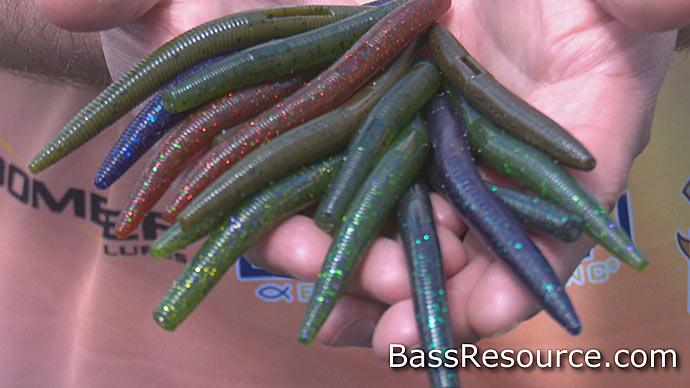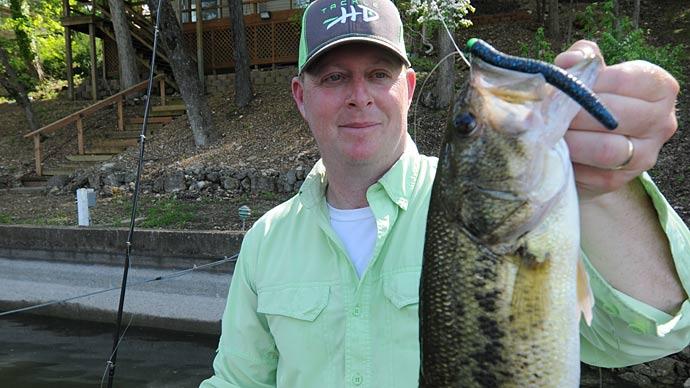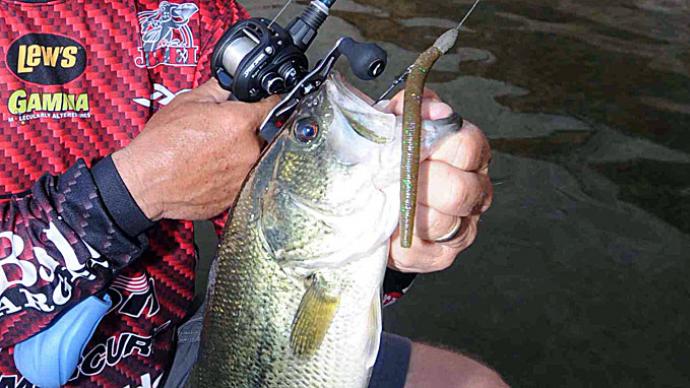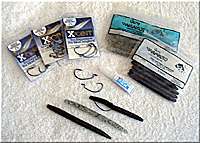
Whenever I want to try out types of baits, I usually buy a few different colors and throw them in the boat. Once they've been stored, finding them sometimes was a problem. Some time ago, I started a system where all the baits I was trying out went into a unique storage bag. Nothing special, just a big freezer-style storage bag. This helped make it much easier when I wanted to try something new. I could grab that bag and try out whatever lure fancied me at the time.
One such bait I picked up and threw into that bag a few years ago, at the urging of a friend, was a soft plastic bait by Gary Yamamoto. It's called a Senko. It doesn't look like much. It is undoubtedly not very similar to other soft plastic baits, except it is long like a worm. Similar to a pencil worm but much thicker. It has no distinct profile in its length like a Sluggo other than the taper from the middle out to both ends and a very fine, almost unnoticeable set of ribs. Kind of like a Centipede, but more of an elongated round shape. It's hard to explain what it looks like. You have to see it. And you have to use it to believe in its fish-catching abilities.
When my friend first showed the bait to me, my first reaction was, "Yeah, right. You catch fish on that thing?" And I thought, here we go again, another lure to catch fisherman. I should have been born in Missouri, the "Show Me" state. I have to see something with my own eyes to believe it. Especially when it comes to new fishing lures. However, I learned two things a long time ago about fishing lures, don't believe everything you hear, and try it before passing judgment.
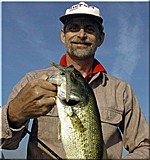
This was undoubtedly going to be one of those lures that I had to see work to believe it. On an outing with my friend, he started using the Senko. While at first, he wasn't having any success, slowly he started catching fish. I thought to myself that he just got lucky on the first one. Then later on another, then another. He only caught three fish on it that day, but that was enough to convince me to give it a try.
I purchased two of the colors he had been using and tried them out on my next trip. No fish. I tried some again on another trip, not to give up too quickly. No fish. But for some reason, I wasn't ready to give up on this lure. After all, I did see my friend catch fish on it. And with my competitive nature, I certainly wasn't going to let him show me up.
A few weeks later, I got the opportunity to fish with this friend again and the guy that introduced the Senko to him. We were filming a segment for a local cable TV fishing show. I was asked to participate as the local expert for that particular body of water. While the camera was rolling during our outing, I finally caught a fish on a Senko.
Something must have clicked for me that day because it's now one of my favorite lures a year later. I have a rod specifically for fishing it, and they have graduated to their special storage box.
A few tips for fishing a Senko
First and foremost, fish it slow. You can not fish this lure too slow! I fish it mainly in the grass. I also fish a lot of clear water, so long casts seem to be critical. Keep a loose line after making your cast, but stay in contact with the lure while it sinks. It takes practice, but this is when a large percentage of the strikes will be. You also must have patience because the lure sinks very slowly.
Another unique feature about this lure, which I think makes it successful, is its uncanny ability to fall with the lure positioned perfectly horizontal while it falls, almost gliding, to the bottom. The slightest movement of the rod tip or line and the lure will dart side to side while still holding that horizontal position.
Although it is heavy enough to fish on a baitcasting rod, use a spinning outfit. Due to its weight, I've found using a medium or medium-heavy action rod is best.
I rig mine Texas-style with a 1/0 to 4/0 Gamakatsu EWG hook, depending on the size lure I'm fishing. I expose the hook through the top of the lure and "pinch" the point just under the body's surface. "Pinching" the hook aids in fewer hang-ups in the grass and allows quick hook-up when a fish takes it. Gamakatsu hooks have an extremely sharp point making hook setting almost effortless with a quick snap of the rod tip.
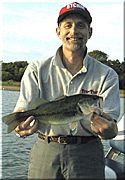
No weight is usually needed. The style and weight of the lure make it heavy enough not to need any in most cases. If fishing very deep water, a weight might be desirable to get down faster. I recommend a toothpick type weight similar to those used on other soft baits of this kind. Placed the weight in the very center or slightly forward so as not to impede the horizontal buoyancy of the lure.
Typically when a fish takes a Senko, it inhales it rather than an aggressive bite. So the strike is almost undetectable, so be on guard. Set the hook on the first slight jump or movement of the line, or if the line feels taught when you pick up the lure. Unfortunately, because of the slight, almost undetectable bite, this creates deep gutted hooksets. Ensure you have a good pair of extra-long nose pliers or cutters handy so the hook can be removed or cut off without harm to the fish.
Due to the round shape of the lure and its movement, you can gather twists in your line quickly, which can be very frustrating. An excellent way to avoid excessive line twists is to use a small swivel about 12" to 18" above the lure.
Anyone who fishes grass or vegetation knows that fishing a worm-type lure is almost impossible without getting it hung up or skewed on the hook. You can reduce the time you spend re-rigging the Senko by placing a few drops of Super Glue (or similar) on the hook eye area before pushing the head up and rigging the lure completely. You must act quickly, though; this glue sets very fast. You can also use glue to put together torn lures if you start to run out of a particular color.
Sometimes I'll insert a rattle. Usually glass with small beads. I use glass mostly because they have a smaller, slimmer profile than the plastic ones. I'll also insert a small weight if the area I'm fishing only has patches of grass I'm fishing around and want to move from one patch to the other more quickly.
The Senko comes in sizes from 4" (Baby Senko) to 7". I'm not sure if the size is important. My friends use the larger 7", but I've become accustomed to mainly using the 5" and 6". It also comes in a variety of colors. I've acquired quite an assortment, but my favorites are clear w/black flake, watermelon w/black flake, Blue/Black w/chartreuse flakes, and Blue/Black w/purple flake. Each seems to work equally well.
Give the Senko a try. I think you'll be glad you did. After you get used to the uniqueness of this lure, you'll discover it has excellent fish catching abilities. Be patient with it, and I think you'll catch more fish. "After all, they call it fishing, but the goal is catching."


